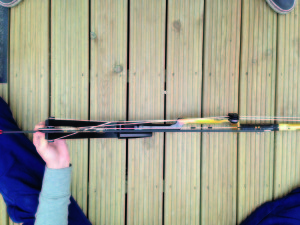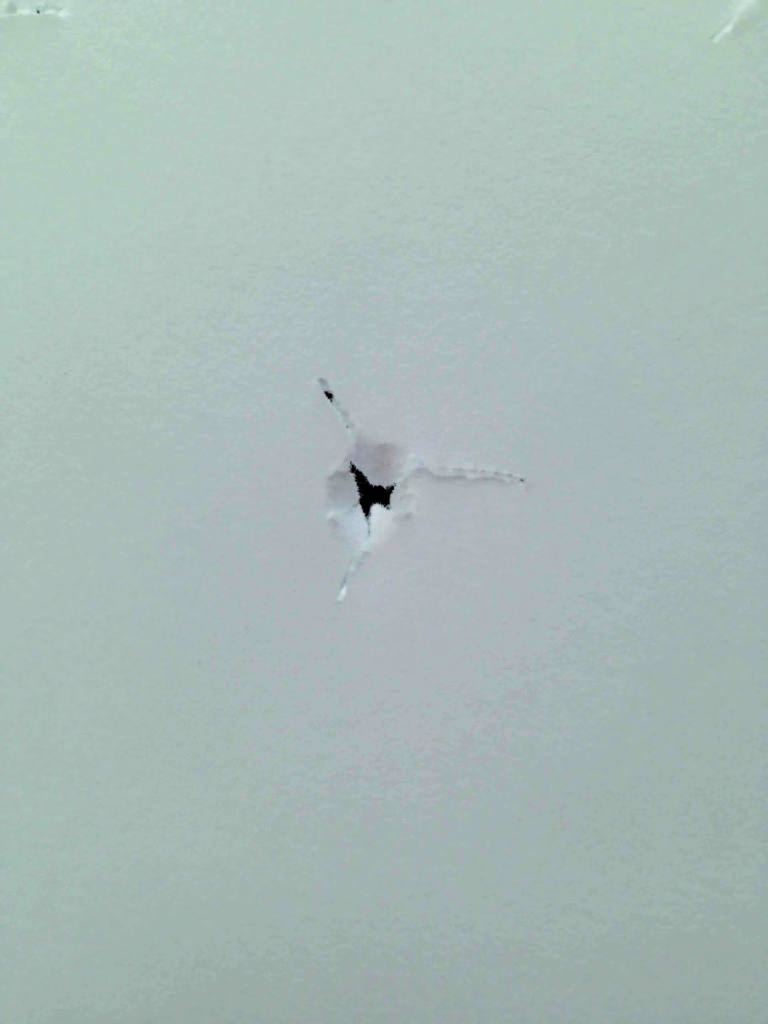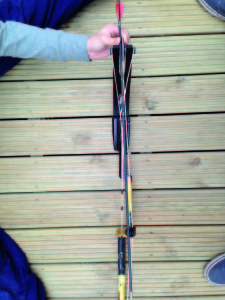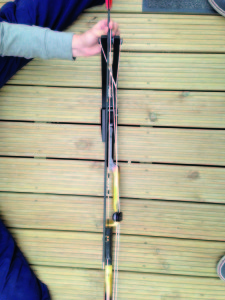In a previous edition of Bow International magazine I wrote about the steps I go through in order to tune my bow. I mentioned that paper tuning is just a starting point, and that I put much more weight on the French tune being perfect.
The French tune is generally set using your arrow rest, but even a perfect French tune does not ensure perfect arrow flight. Once the French tune is complete I would recommend heading back to the paper tune to see what you’re left with. If your paper tear is now out there are steps you can take to correct this. This correction can be done by moving the position of the string left and right in order to perfect your paper tear.
This method will only help to correct a left/right tear and will not have any impact on your vertical tear through paper. The string can be quite simply adjusted left to right by adjusting the angle of your top cam or wheel using the yoke cable.
Most modern compounds are designed with a cable that runs from the bottom cam up to the top of the bow. Approximately six inches from the top, the cable splits into two, and the two cables are attached to either side of the top limb. This split cable is called the ‘yoke’ cable. By twisting each side individually it will allow you to adjust the angle of the top cam or wheel in relation to the riser. By moving the angle of the cam, you will automatically cause a slight adjustment to the position of the string in relation to the riser.
There is a common myth that your top cam or wheel must be straight up vertically in order for it to be set correctly. However, I would always use true vertical as a starting point when setting up my bow, as it does not have to remain straight to get a good tune. You should think of adjusting your cam angle no differently to the way you would think about a small adjustment to your rest. I have shot some great scores with a slight angle on my top wheel. This small adjustment can also help to offset any issues you may have with your grip or anchor.

Use a straight edge like a parallel shaft to determine your top cam angle, and start with it in the vertical position
Firstly, you need to ensure that your cam or wheel is set in a true vertical position to begin with. This is done by laying a straight edge against your top cam. A straight parallel arrow is perfect for doing this check – I wouldn’t use a bent arrow, or a barreled shaft, to do this as it will throw you off. Holding the arrow against the cam, it should cast a line down the centre of the limbs and riser. Do not compare your arrow to the string, as the string will be slightly off due to its fitting position on the bottom cam. If the top cam leans left, put some twists into the right-hand side yoke. If the top cam leans right, put some twists into the left-hand side.
Once you are certain that your top cam or wheel is up straight, shoot another arrow through paper. I would do this at about five yards back from the paper. If your tear is now perfect, then you have nothing further to worry about.
If you have a right tear, this means that the nock and fletchings are clearly visible to the right of where the arrow point is. To correct a right tear you should put two twists into the right hand side yoke. Then shoot another arrow through paper and see if there’s any change or improvement. You may need to add or remove twists to get the hole perfect.
If you have a left tear through paper this means that the nock and fletchings are to the left-hand side of where the point has passed through the paper. To fix this, put two twists into the left-hand side of the yoke cable.
This process is very much a case of trial and error. There is no fixed formula to say anything like, for example, that one twist equates to three millimetres of tear. It is very different for each individual bow. A bow with larger diameter cams will naturally lean more with the same number of twists than a bow with smaller diameter cams, so the adjustments will be finer. On a bow like a Mathews C4, the idler wheel is very small, so it will take a larger number of twists to move the wheel alignment and see an impact on the paper tear.
One thing to be careful of during this process is to make sure you put no more than six twists in each individual side of the yoke cable. If you lean the cam too much there is a risk of the string leaving the track and the bow de-railing, so when you have found true vertical for the top cam never go more than six twists in either given direction.
In my experience, this method of cam leaning works extremely well on any bow with a large diameter cam. This method will not fix everything, and perfect form is still the best head-start to getting a perfect tune. However, it will help to eliminate a small amount of error in your arrow flight and can just put that finishing touch in your tuning that you have been looking for.







this is something I never heard of before but I will certainly give it a try if other tuning methods don’t do so good but for now I will stick to paper tune and walk back. Your presentation on this very well done. If I have future problems can I call on you?
Howdy! This post couldn’t be written any better! Reading through this post reminds
me of my previous room mate! He always kept talking about
this. I will forward this article to him. Fairly certain
he will have a good read. Thanks for sharing!
Thanks for any other wonderful article. Where else may just anyone get that type of information in such an ideal approach of writing?
I’ve a presentation next week, and I’m on the search for such information.
Admiring the time and effort yoou put into your website and iin depth
information you present. It’s awesome to come across a blog
efery once iin a while that isn’t the same out of dte rehashed information.
Fantastic read! I’ve saved your site and I’m adding your
RSS feeds to my Gogle account.
Very clear information regarding cam lean, I’ve searched other websites about this topic, and I was very much confused about paper tuning/cam lean from those other sites. Now I know how to do paper tuning the right way. Thank you so very much!
I continued to view your 2 pictures on left/right cam lean by using an arrow. I was told that my bow both cams were leaning in the opposite directions. Upon my return home, I took an arrow and a Spot Hogg laser aligner to see if I did have both cams leaning. I deterimne that the human eye-ball is not the best way in determining if you do have any cam lean. I determined by using both methods, I have NO cam lean, this shop may had wanted to sale me some new string/cables for my bow. The sale will be cancelled. Thank You Again!
You mention about tuning out upper cam lean, what about the lower cam lean. I have no yoke on my lower cam, it’s attached to the axle but it has quite a bit of lean, can this be tuned out, say buy shimming one side of the limb or something or is the lower cam not a factor. Top and bottom cams are almost the same, bow is a Bear Anarchy
Thanks for the great report. Brian
great advise,had a terrible left tear on my sr71 with the cam at zero lean,4 twists on left yoke and viola bullet hole !!!
Does this affect holding weight or draw weight?
I’ve been battling the Hyperedge for a week. Left high initially. I’ve had this bow for 4 years, since new, and never shot it.
First I read that the bottom cam can sometimes touch the bus cable. Seemed like there was a good 1.5mm of clearance, but after a few hundred arrows I could see the serving getting a little shinny on one side. So I shimmed it out under the draw length module. This fixed the high part.
Now I had a solid left to battle. Same thing, shooting 400 spine at 52-57. Same problem.
Read the thread and tried twisting the left yoke one turn at a time. At 3 1/2 turns I had it! Bullet holes at 5 yard.
Thank you!!!!!!!